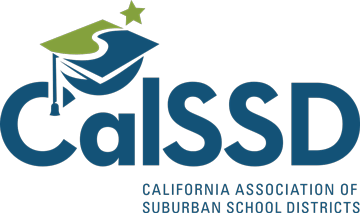CALSSD May Revision Budget Recommendations
The Hon. Toni Atkins
Senate President pro Tempore
1021 O Street, Suite 8518
Sacramento, CA 95814
The Hon. Anthony Rendon
Speaker of the Assembly
1021 O Street, Suite 8330
Sacramento, CA 95814
The Honorable Nancy Skinner, Chair
Senate Budget & Fiscal Review Committee
1020 N Street, Room 502
Sacramento, CA 95814
The Honorable Phil Ting, Chair
Assembly Budget Committee
1021 O Street, Suite 8230
Sacramento, CA 95814
The Honorable John Laird, Chair
Senate Budget Subcommittee No.1 on Education
1021 O Street, Suite 8720
Sacramento, CA 95814
The Honorable Kevin McCarty, Chair
Assembly Budget Subcommittee No. 2 on Education Finance
1021 O Street, Suite 4250
Sacramento, CA 95814
Re: CALSSD May Revision Budget Recommendations
Dear Senate President pro Tempore Atkins, Speaker Rendon, Senator Skinner, Assemblymember Ting, Senator Laird and Assemblymember McCarty:
The California Association of Suburban School Districts (CALSSD) appreciates your leadership in crafting a budget that uses the state’s historic revenues to provide significant increase to on-going LCFF funding in recognition of the challenge of sustaining the programs and services our students and to providing one-time discretionary funds to meet local priorities. Balancing ongoing and one-time funding is critical given the indicators of the onset of a recession within the next two years. We write now to share CALSSD recommendations on priority funding and policy proposals.
Local Control Funding Formula (LCFF) Higher LCFF Base Grant and ADA Calculations
We deeply appreciate the recognition in the May Revision and in the priorities already identified by the Assembly and Senate to invest significant ongoing funding into LCFF, the major source of funding for most districts. We support the May Revision COLA of 6.56% and additional investment in the formula of a significant increase to the Base Grant. This funding addresses rising costs for responsibilities and operational costs that are not supported by supplemental, concentration for special funds.
Districts experienced steep increases in absences early in calendar year 2022 due to COVID-19 variants. This dramatically impacts not only the current year ADA but the three-year average ADA calculation and funding levels in subsequent years. We support the May Revision proposal to allow all classroom-based local educational agencies (LEAs) to be funded in 2021-22 at the greater of their current year ADA or current year enrollment adjusted for pre-COVID-19 absence rates. We support the Governor’s Budget proposal to change the calculation of ADA to allow districts to be funded at a three-year average or current or prior year ADA.
Discretionary Block Grant to LEAs Allocated on a Per Pupil ADA Basis
We support the May Revision proposal for a significant discretionary block grant to LEAs to be allocated on a per pupil or ADA basis. This allocation recognizes local context and allows districts to address continued need for student mental health and wellness as well as for operational costs that continue rise including energy, utilities, technology, equipment. Given the number of funds allocated based on student demographics, e.g., Extended Learning Opportunities Program, LCFF, Community Schools Grants, Literacy Grants, we urge the Legislature to adopt the per ADA basis for the allocation method of the block grant.
Pension Relief for Local Educational Agencies
Employer pension rates are set by the state and are scheduled to increase in 2022-23. Without a contribution from the general fund to maintain employer contribution rates flat, LEAs and community colleges face rate increases in CalSTRS of approximately 2.18% and 2.16% for CalPERS; a single-year pension cost increase of $1.2 billion starting July 1, 2022. CALSSD supports an investment from the state surplus to address this immediate rise and employers’ long-term unfunded liability. This investment will provide sh relief to LEAs and result in more funds for classroom support to students.
Special Education Funding
The May Revision provides the 6.56% COLA to special education and maintains the January Budget proposal to increase the special education AB 602 grant to $820 per pupil. We support this proposal because more and more children are being identified for special education services; thus, program costs are increasing even as overall enrollment numbers and ADA are declining. Because special education funding is based on a district’s ADA, this increase is especially important.
Facilities Funding for Transitional Kindergarten Expansion
CALSSD urges the Legislature to provide an allocation of funds to support educationally appropriate facilities for universal transitional kindergarten (TK). As schools expand this grade level, the challenges of accommodating more and younger 4-year-olds on school campuses will require facilities modifications to meet Title 5 standards for restrooms, windows, sinks, furniture, parent drop-off and bus loading areas, and playgrounds.
Home to School Transportation Funding
CALSSD is a long-time champion of reforming the Home to School Transportation formula; our districts recognize the critical importance of ensuring students have the means to get to and from school. We support the approach of AB 2933 (O’Donnell) and urge the Legislature to provide additional ongoing funding without a state mandate.
Thank you for the opportunity to share the recommendations. If we can be of further assistance, please contact me via e-mail at andrea@ballfrostgroup.com or phone at (916) 616-3116.
Sincerely,
![]()
Andrea Ball, Legislative Advocate
California Association of Suburban School Districts
